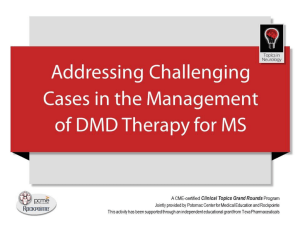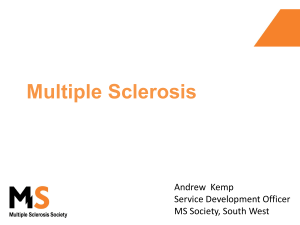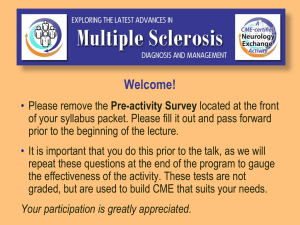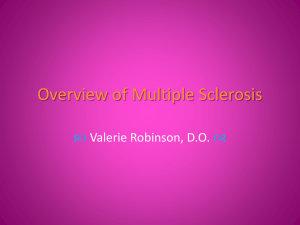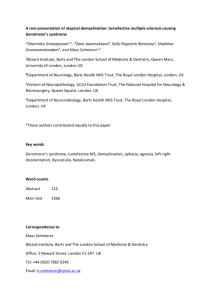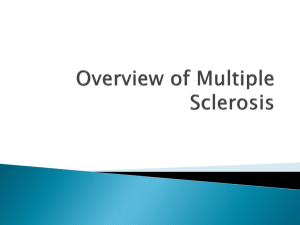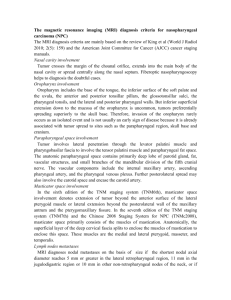New treatments in MS What’s here and what’s nearly here David Miller
advertisement
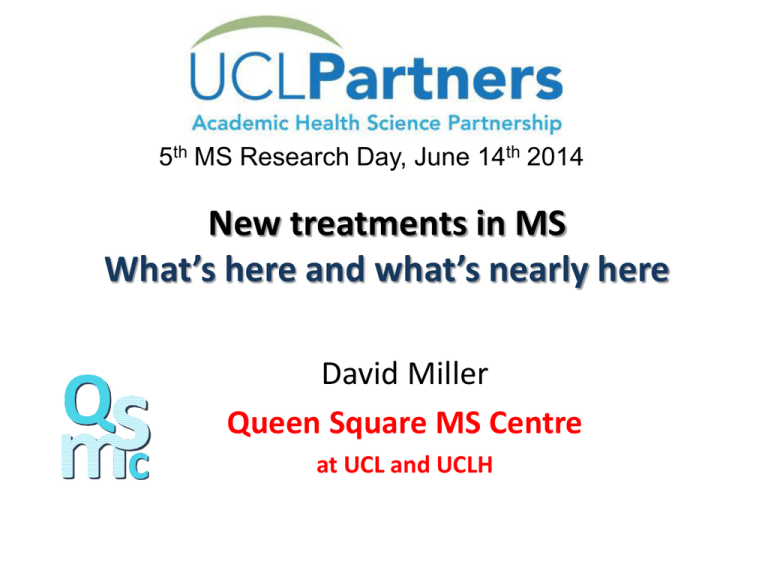
5th MS Research Day, June 14th 2014 New treatments in MS What’s here and what’s nearly here David Miller Queen Square MS Centre at UCL and UCLH Course of MS and its treatment Relapsing remitting Secondary progressive Disability Primary progressive Progressive relapsing Time in years Aims of treatment • Prevent relapses and associated disability • Prevent progressive disability • Reverse persistent disability Aims of treatment • Prevent relapses and associated disability √ • Prevent progressive disability X • Reverse persistent disability X Current treatments are for relapsing remitting MS Relapsing remitting Secondary progressive Primary progressive Progressive relapsing Time Time in years Problems measuring relapses • Insensitive measure: “tip of the iceberg” • Large and expensive treatment trials • Trials don’t address very long-term effects Relapsing remitting MS: Monthly MRI: new lesions 10 new lesions per one relapse New MRI lesions = good “surrogate” for relapses in more than 50 MS trials Decreasing MRI lesions Decreasing relapses Sormani et al Lancet Neurology 2013 Treatments work by impeding the immune cells that cause new lesions and relapses Immunomodulation Immunosuppression Less effective More effective Fewer side effects More side effects What’s here • β-(beta)-interferons – – – – Avonex Rebif Betaferon Extavia Injection into muscle once a week Injection under skin 3 times a week Injection under skin every second day Injection under skin every second day • Glatiramer acetate – Copaxone • Natalizumab – Tysabri • Fingolimod – Gilenya Injection under skin every day Injection into vein once a month Tablet once a day ß-interferon • Immunomodulation • Reduces relapse rate by 30% • Reduces new MRI lesions by 60% • Good long term safety Glatiramer acetate • Immunomodulation • Reduces relapse rate by 30% • Reduces new MRI lesions by 40% • Good long term safety NHS “risk sharing scheme” for β-interferon & glatiramer acetate • Criteria for treatment • Two relapses in two years • Able to walk • 6-year analysis = cost-effective Natalizumab (Tysabri) • Immunosuppression (novel) – Prevents immune cells going from the blood to the brain • • • • Reduces relapse rate by 70% Reduced new MRI lesions by 90% Reduces disability by 40% Recommended by NICE for NHS (2007) Blood-brain barrier Brain Natalizumab: side effects • Allergic reactions • Progressive multifocal leucoencephalopathy (PML) PML Risk Stratification* JCAnti-JCV Virus Antibody antibodyStatus test Negative Positive (50%) Prior IS Use 1 in 1,429 1 in 556 No 1 in 10,000 1 in 189 Natalizumab Exposure 1–24 months 0.1/1000 25–48 months 95% CI 0.01-0.35 1 in 164 49-72 months (50%) No Prior IS Use Yes Prior IS Use 0.7/1000 1.8/1000 95% CI 0.5-1.0 95% CI 1.1-2.7 5.3/1000 11.2/1000 95% CI 4.4-6.2 95% CI 8.6-14.3 6.1/1000 Insufficient data 95% CI 4.8-7.8 1 in 89 Data beyond 6 years of treatment are limited. There are insufficient data to adequately determine PML risk in anti-JCV antibody positive patients with prior IS use and >48 months of natalizumab exposure. *Based on natalizumab exposure and 343 confirmed PML cases as of 5th March 2013. Prior IS data in overall natalizumab-treated patients based on proportion of patients with IS use prior to natalizumab therapy in TYGRIS as of May 2011; and prior IS data in PML patients as of 5th March 2013. The analysis assumes that 55% of natalizumab-treated MS patients were anti-JCV antibody positive and that all PML patients test positive for anti-JCV antibodies prior to the onset and diagnosis of PML. The estimate of PML incidence in anti-JCV antibody negative patients is based on the assumption that all patients received at least 1 dose of natalizumab . Assuming that all patients received at least 18 doses of natalizumab, the estimate of PML incidence in anti-JCV antibody negative patients was generally consistent (0.16/1000; 95% CI 0.02–0.56). Biogen Idec, data on file. NICE Criteria for natalizumab treatment • 2 disabling relapses in 12 months + new MRI lesions Fingolimod (Gilenya) • Immunosuppression (novel) – Traps immune cells in lymph nodes • Reduces relapse rate by 50% • Reduces new MRI lesions by 75% • Reduces disability by 30% • Recommended by NICE for NHS (2012) Fingolimod: mechanism of action (Sphingosine) Fingolimod: side effects • • • • • Herpes infections (can be severe) Heart block with first dose (ECG monitoring) Blurred vision (swelling back of eye) Abnormal liver function High blood pressure NHS England criteria for fingolimod • Relapses on β-interferon or glatiramer acetate • High PML risk on natalizumab What’s nearly here • Teriflunomide – Aubagio Tablet once a day • Dimethylfumarate – Tecfidera Tablet twice a day • Alemtuzumab – Lemtrada Injection into vein every day for 5 days then again one year later for 3 days Teriflunomide (Aubagio) • • • • Immunomodulation Reduces relapse rate by 30% Reduces new MRI lesions by 50% Recommended by NICE for NHS (2014) Teriflunomide: side effects • • • • Nausea, diarrhoea Hair thinning Abnormal liver function Must avoid in pregnancy NICE criteria for teriflunomide treatment • Two relapses in two years Dimethyfumarate (Tecfidera) • • • • Immunomodulation Reduces relapse rate by 50% Reduces new MRI lesions by 75% NICE appraisal: on-going Dimethylfumarate: side effects • • • • Flushing Nausea, abdominal pain, diarrhoea Abnormal liver function Low white blood cell count Alemtuzumab (Lemtrada) • Immunosuppression – Depletes immune cells from the blood • Reduces relapses, disability and new lesions by 50% compared to β-interferon • Recommended by NICE for NHS (2014) – Active relapsing remitting MS Alemtuzumab: side effects • • • • • Infusion reactions Infections (including herpes) Overactive thyroid Internal bleeding (low platelets) Kidney failure (rare) Effectiveness and risks of treatments 3.5 3 Natalizumab Alemtuzumab 2.5 2 Fingolimod Dimethylfumarate 1.5 Increasing risks 1 β-interferon Glatiramer acetate Teriflunomide 0.5 0 0 0.5 1 1.5 2 2.5 3 Increasing effectiveness 3.5 Options for treating relapsing remitting MS • • • • • There will very soon be 10 different treatments Their benefits and side effects vary More benefit ≈ more side effects Different treatments will benefit different people Should be able to control relapses in most people Future treatment of relapsing remitting MS • More new treatments on the way • Combination treatments • Personalised treatment • Long term benefit and safety

